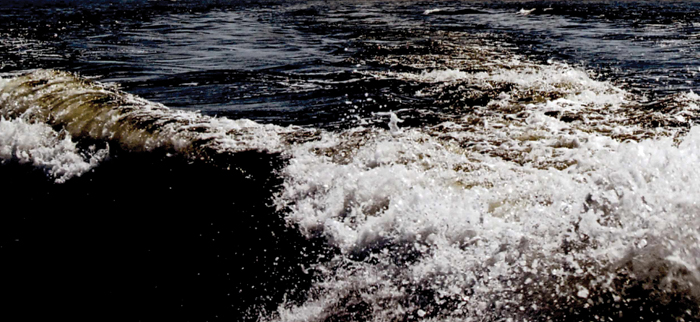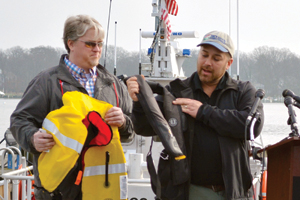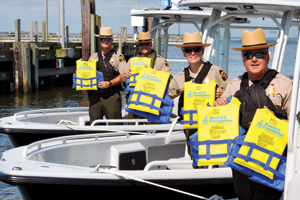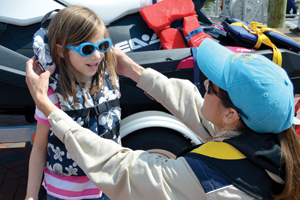It Can Happen to You: How to stay safe on the water

Wake; department photo
Brad Stemcosky is a careful boater. He knows all the rules and owns all the best safety gear.
Experienced and cautious, he’s a walking poster boy for boating safety.
Yet on a late December afternoon last year, he and a fishing buddy were flailing in the frigid waters of the Potomac River, the day’s light failing and their options running out.

Survivors speak about their safety gear; by Candy Thomson
A cautionary tale
As they returned from Maryland’s final day of striped bass season, their 16-foot fishing boat developed mechanical trouble, took on water and sank. Stemcosky and Charlie Frend Jr., were in a fight for their lives.
“In a matter of five, 10 seconds, all of a sudden everything changed, and you’re in really cold water,” recalls Frend.
Their life jackets—which they put on before they left the dock—inflated. Stemcosky called for help on his cellphone and handheld VHF radio.
“The water is getting colder. It’s dark. You’re floating around like an empty water bottle, wondering if anyone has heard you,” Stemcosky says.
After more than an hour, a spotlight pierced the pitch-black sky, the pounding sound of helicopter filled the air. Rescue boats arrived, and the two men were quickly on the deck—exhausted and shivering, but safe.
They were treated for hypothermia at a local hospital.
Stemcosky told the Natural Resources Police that the boat sank so fast that, had they not been wearing life jackets, neither he nor Frend would have had time to put one on.

Life jackets donated by BoatUS; by Candy Thomson
“They are living examples of what Natural Resources Police has been trying to drive home—to be prepared when going on the water,” says Lt. Col. Ken Ziegler, acting superintendent.
Cool and inviting, water is the primary ingredient for many a recreational adventures in Maryland, whether for fishing, paddling, sailing or exploring.
But as Stemcosky and Frend learned, it doesn’t take much for a tranquil day to turn deadly.
Wear it
Last year, 22 people perished in boating accidents in Maryland waters, the greatest number since 1995. All but a handful of the victims were wearing a life jacket—the key to survival.

Life jacket fitting; by Candy Thomson
Maryland law requires that all children under the age of 13 must wear a well-fitting, Coast Guard-approved life jacket while aboard a boat less than 21-feet long that is moving. A child under the age of four must wear a life jacket that has a strap that goes between the youngster’s legs to secure the front of the jacket to the back and has either an inflatable headrest and high collar or a grab strap.
“Life jackets only work when you wear them,” Ziegler says. “People think that in an accident they will have time to grab a life jacket and put it on. That’s like thinking you can put on a seat belt while you’re having a car accident.”
Officers who find boaters without life jackets or with an insufficient number of life jackets aboard will issue citations to the operators and order them to return to shore. The maximum penalty for failing to have a sufficient number and appropriate style of life jacket aboard is $500.
| Resources
The Boating Safety Unit of the Natural Resources Police lists information on safety courses, water access sites, regulations and requirements, licensing and more. The National Safe Boating Council advocates safe boating through education. It provides trainings and programs through more than 330 nonprofit and private organizations throughout the United States and Canada. Wear It! The council uses this simple phrase to encourage boaters to remember to always wear their life jackets. They offer specific information about different types and uses, as well as visual aids to help spread the word. They also sponsor National Safe Boating Week, occurring this year May 21-27. The U.S. Coast Guard Auxiliary offers instruction to boaters of all ages and levels. Classes are listed by topic and can be found locally by zip code. |

Girl demonstrates proper wear; by Stephen Badger
Boat smart from the start
The Natural Resources Police urges every boater to do a stem-to-stern equipment check before venturing out for the first time this season. Active and reserve officers will be conducting safety inspections at boat ramps and on the water.
Have a horn, bell or whistle aboard to signal for help and a set of flares to mark your position at night. Make sure flares aren’t expired and the fire extinguisher is charged.
Before you get underway, tell someone where you are going and when you plan to return. Check the weather forecast and be ready to head for shore if warnings are issued.
Finally, do what Stemcosky did: Carry a cell phone in a waterproof container, and if you have a marine radio, monitor VHF Channel 16.
“You don’t think it’s going to happen to you,” Stemcosky says. “And then it is you and you can’t believe how quickly it happened.”
Article by Candy Thomson—Natural Resources Police public information officer.
Appears in Vol. 19, No. 2 of the Maryland Natural Resource magazine, spring 2016.


 1-888-373-7888
1-888-373-7888 233733
233733